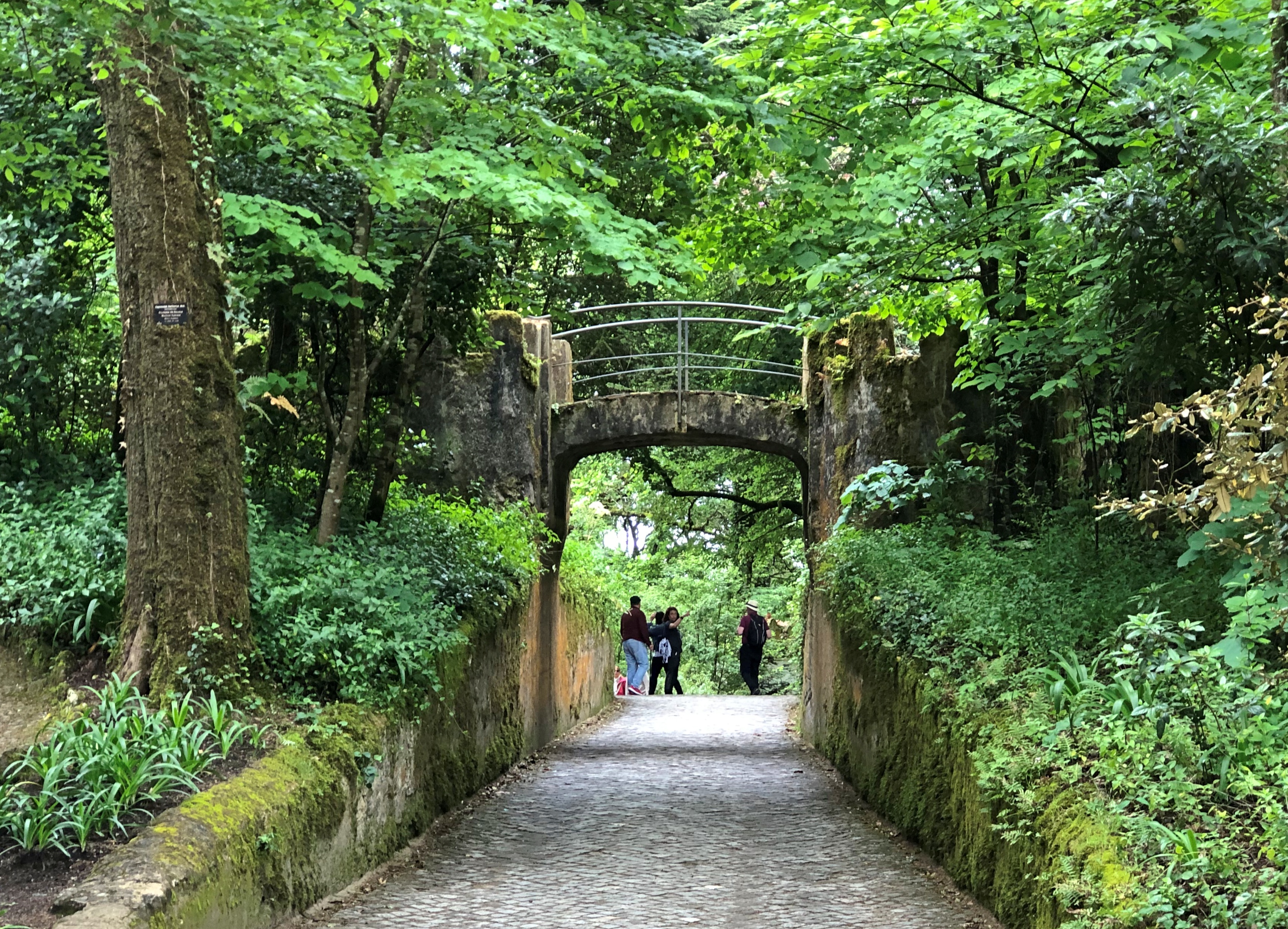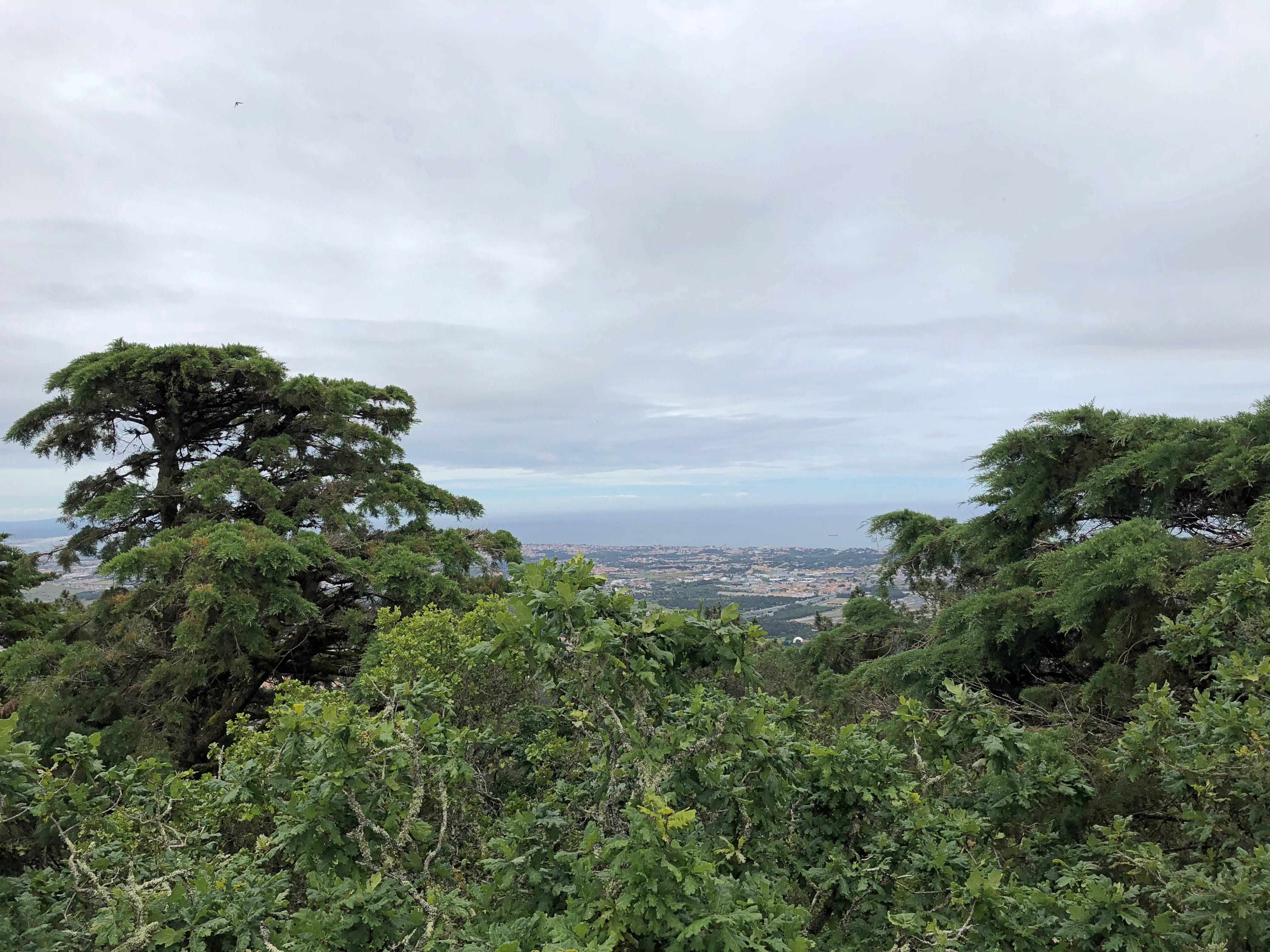Forty minutes west by train from the sweeping 19th-century Rossio Railway Station, formerly Lisbon’s main train station, is the municipality of Sintra, which is at the end of one of the lines from Rossio. The cost to get there is modest, €2.30 each way, plus €0.50 one-time for a magnetic card, and the trains come often, since it counts as a commuter line.
Like any modern city, Lisbon sprawls out from its center, including in the direction of Sintra, and people used a number of the intermediate stops. But maybe nine out of ten riders on the mostly full train to Sintra were tourists going to the end of the line. Or at least that happened mid-morning on May 16, a Thursday, when we joined them.
Besides suburban-ish districts – which in a Euro-context means apartment blocks and small shops close to stations – we passed an inordinate amount of graffiti on the way. Every manmade surface you could see from the train window seemed to be covered with it – concrete walls, signs, small towers and other fixtures. Mostly tedious signature-style graffiti, not depictions of any kind, though if you spend enough time in greater Lisbon, you can find enough of that. Either a few Portuguese graffiti makers have a lot of time on their hands, or many young (I assume) Portuguese try their hand at it. Or, for all I know, Portugal attracts taggers from around the EU.
As a settlement, Sintra isn’t a function of modern sprawl. People have been in the Sintra hills since Paleolithic times. More recently (on a scale that includes the Paleolithic), members of the Portuguese upper class, whatever the form they’ve taken over the centuries, made the place their own. That includes, most importantly for the purposes of attracting travelers, Portuguese royalty. The kings are gone, but their visible legacy lives on in the form of palaces and other structures, which packs ’em in, in our time.
One in particular is an enormous draw: Pena Palace.
“Around 1840, Ferdinand II turned a ruined monastery into a castle in which Gothic, Egyptian, Moorish and Renaissance elements were displayed,” UNESCO gushes just a bit about the palace, since the district is another of Portugal’s World Heritage Sites.
“He surrounded the palace with a vast Romantic park, unparalleled elsewhere planted with rare and exotic trees, decorated with fountains, watercourses and series of ponds, cottages, chapels and mock ruins, and traversed by magical paths. He also restored the forests of the Serra, where thousands of trees were planted to supplement the oaks and umbrella pines which made a perfect contribution to the romantic character of the Cultural Landscape of Sintra.”
Pena Palace is quite the sight, even from below.
We got to that view via a municipal bus that circles the hills, stopping at the train station and then a number of sights, and which comes every few minutes; and then a small bus belonging to the palace for a few euro more, to climb up the steep hill toward the palace. There were lines for each of these modes, but not a lot of waiting, so efficient is modern Sintra at shuffling around tourists.
One thing we’d been warned to do – I had been warned, via online guide sights – was reserve a time for the palace. I made no attempt to do so until the evening before, when the only tours available online were the last ones of the day. We weren’t sure we’d still be in Sintra then, so we didn’t book for then. A tramp around the grounds and a look at some of the other sights ought to be enough, we figured. But we did ask at the palace ticket counter around 11 if anything was available that day. Yes, 2:30, she said.
So we got to see the palace. But not before we had time to visit the garden – forest – Romantic greenery around the palace. The Parque de Pena. Which meant going down, since the palace is on a hilltop. Down lush hillsides.

Note the handful of people. This was in great contrast to the crowds waiting to get into the palace. Later, we also waited to get into the palace, so I don’t begrudge their massing at that place. Just pointing out that not far away, the crowds are gone.
Signs pointed to a number of features and how many meters you had to walk to reach them. We picked the High Cross. That name might have been a hint of the climbing that was to come. Admiring natural beauty might be a precept of the Romantic movement, but none of the Romantic poets (that I know of) dwelled much on how accessing said beauty might involve a tiring walk. Unless the original title was “Lines Written a Few Miles above Tintern Abbey, and Boy Am I Tired.”
The climb was entirely worth it, I have to add. Eventually the path narrows and you reach the cross.

Later, when we had a view from the palace, we saw that the cross is at the highest point in these hills. As such it offers good views, though partly obscured by foliage and that day by haze.
The Atlantic Ocean’s out that way, I think.
Returning meant going down hill from the cross but eventually uphill again, to reach the palace. The visitor center cafeteria was open, and we had time to eat and especially drink before our mid-afternoon tour. It was a satisfying repast. We had no bad meals in Portugal, not even at a tourist cafeteria.
It was cool and cloudy the day we visited Sintra, but climbing the hills was still thirsty work.


